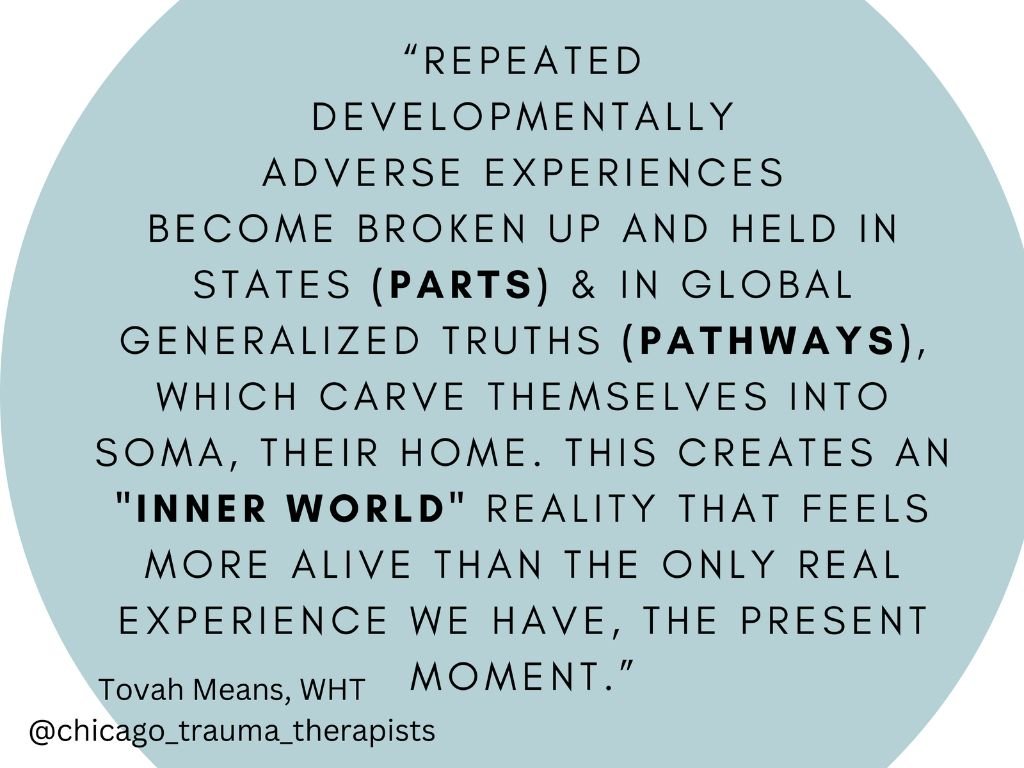Parts & Presentations: Complex Trauma & Dissociation of the Self
On March 22, Meredith Glick, LCSW and myself will be presenting a workshop on dissociative parts and presentations of parts. In advance of the workshop, I wanted to write a blog about doing parts work with complex trauma survivors, and hopefully provide some much needed context for the words, “Parts” and “Parts work”. These terms are being used more in therapeutic language, as people try to understand the skills needed to treat trauma survivors.
In this blog I am focusing on dissociative traumatized parts that are caused by needing to organize the self dissociatively during repeated childhood trauma in order to survive the unthinkable. This is different than general parts work - where we understand that humans have parts and and do not experience consciousness in only one light - but through multiple lenses and identities, all crafted by internalizing our family and culture into our own sense of self. Dissociative parts work requires a certain set of skills from the therapist, as these parts are often invisible, behind the scenes running aspects of our client’s lives without awareness.
It’s really important to develop some underlying principles about how to work with dissociative parts, but then to allow every individual surprise you with their own unique internal worlds. What I’ve seen from working with complex and dissociative people for 15 years is that each one is incredibly unique, complex, and non-verbal. Finding words and names and references and metaphors and stories are all the work of healing parts. I come to parts work with no pre-set language, except for the word “parts”, which is still only a partial estimation of what creative language exists inside someone.
What are Parts?
In my experience, dissociative parts are one piece of an incredibly devastating and complex inner reality of the self. Some clients can see and feel some of these injured parts, and some people will miss them all together, depending on the severity of their childhood. They will be invisible and unavailable for “parts work” without the help of someone seeing them in the outside world.
What is Parts Work?
The goal of any complex trauma therapy is integration. It’s a daunting word and concept, one that I’ve been trying to untangle for a decade. A client asked me last week what the goal of our parts work was. How would doing parts work help her heal from the impact of her developmental losses? I tried to give her a brief overview of what I find myself doing with client’s parts every week during sessions, and how I think it helps to resolve trauma:
First, trauma parts have to be seen as trauma parts: Parts will evolve in their self-awareness as relationships (yours and others) become safer. Therapist must use the self in session to detect, notice, and track the presence of parts.
Second, parts need to decide if they think they can trust us and work with us: Relationship building and permission seeking is the first part of “parts work”. Trying to bypass this will only produce defenses.
Then, it’s the team’s job to help stop the bleeding: Trauma parts are in their injuries, and have been for a very long time. They will not be able to move towards change until we understand and listen to the injuries. Therapists need to work with the immediate safety issues that clients bring to treatment. This will help build trust and show the parts that they are a part of a larger system that has developed to manage their childhood trauma. Trying to skip past stabilization and safety building will not provide a safe road for memory work.
The team needs to notice trauma responses that are happening in present day, to lead the clinical dyad to memory work: Memory work sits in between safety work and having enough attachment to the therapist to be able to handle the affect dysregulation of memory work.
When the team is ready, go to memory with caring others - self and therapist: Parts need to tell stories for as long as needed in order to resolve the story they are stuck in. Parts need a lot of space to tell stories, to remember context, to make sense of the harm and to grieve.
Telling stories and showing the memories that parts are stuck in will begin a process of ending the silence and the shame of being abused.
We must react to the parts experience in the memory. Attune, empath, and grieve deeply for the injury. Parts will feel cared for, rescued, helped by building a compassionate self and modeling from the therapist. Each part will need as much time memory work as they need.
Regulation occurs in this manner - love the self and be loved by others. Trauma responses are regulated and grounded, building a new pathway away from trauma.
We do this work with each part until they are resolved. We go back again and again until the part feels more resolved, more free, more accepted. Resolution looks like living in the here and now more and more. Clients learn to experience feelings without dissociating. You will watch your client resolve somatic issues, learn to take care of themselves, and love themselves. Some parts will be developing from very young ages where they were frozen by trauma.
Work is long term, and parts reveal themselves deliberately, according to what the mind can handle.
Come learn more about parts and how they present themselves to us in our workshop! For more information or to register: https://www.eventbrite.com/e/dissociative-parts-and-presentations-tickets-747433171737?aff=ebdsoporgprofile
